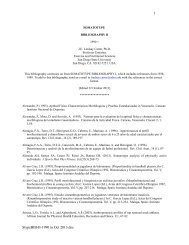THE HEATH-CARTER ANTHROPOMETRIC ... - Somatotype.org
THE HEATH-CARTER ANTHROPOMETRIC ... - Somatotype.org
THE HEATH-CARTER ANTHROPOMETRIC ... - Somatotype.org
Create successful ePaper yourself
Turn your PDF publications into a flip-book with our unique Google optimized e-Paper software.
<strong>Somatotype</strong> Instruction Manual 9<br />
The somatotype photograph is a valuable record of the physique, especially when change is<br />
expected and for longitudinal growth studies. It can be used as a supplement to the anthropometric<br />
somatotype rating, in assessment of body image, and in association with the anthropometric profile.<br />
Even if you are not a qualified somatotype rater, you can look for the correspondence between the<br />
anthropometric somatotype and what you see in the photograph. In other words, the photo provides<br />
you with the visual image of what a particular 2-5-3 or 6-3-1 looks like. Details of how to rate the<br />
photographs, with examples, are described in Carter and Heath (1990, App. I).<br />
The somatotype photograph requires standardized poses of front, side and rear views of the<br />
subject. The recommended minimal equipment consists of a good quality 35 mm camera, with an 80<br />
mm lens and attached flash. The camera should be mounted on a tripod, at 5.8 m from the subject and<br />
the lens height at approximately mid-stature for most subjects in the sample. Commercially developed<br />
standard color print film (ASA 200 or 400) is quite satisfactory and relatively inexpensive. The subject<br />
should be dressed in minimal clothing such as light-weight swim suits (single or two-piece), or running<br />
shorts. A more permanent somatotype station should include a data board, turntable, standard scale,<br />
white background, and flood or flash lights. (See Carter & Heath, 1990, App. I, for other options.)<br />
Digital photography is now a viable option if care is taken to keep the focal length long to reduce<br />
distortion of the physique.<br />
<strong>Somatotype</strong> categories<br />
<strong>Somatotype</strong>s with similar relationships between the dominance of the components are grouped<br />
into categories named to reflect these relationships. Figure 7 shows somatotype categories as<br />
represented on the somatochart. The definitions are given below. Subject 573 is an ectomorphic<br />
mesomorph (or ecto-mesomorph), and subject B-188 is an endomorphic ectomorph (or endoectomorph).<br />
All other somatotypes plotted within the same area are assigned the same category name.<br />
The frequencies of somatotypes within categories (or combined categories) can be used to describe the<br />
overall distribution of samples or for comparing them using a Chi-square analysis. The definitions of 13<br />
categories are based on the areas of the 2-D somatochart (Carter and Heath, 1990).<br />
Central: no component differs by more than one unit from the other two.<br />
Balanced endomorph: endomorphy is dominant and mesomorphy and ectomorphy are equal (or do<br />
not differ by more than one-half unit).<br />
Mesomorphic endomorph: endomorphy is dominant and mesomorphy is greater than ectomorphy.<br />
Mesomorph-endomorph: endomorphy and mesomorphy are equal (or do not differ by more than onehalf<br />
unit), and ectomorphy is smaller.<br />
Endomorphic mesomorph: mesomorphy is dominant and endomorphy is greater than ectomorphy.<br />
Balanced mesomorph: mesomorphy is dominant and endomorphy and ectomorphy are equal (or do<br />
not differ by more than one-half unit).<br />
Ectomorphic mesomorph: mesomorphy is dominant and ectomorphy is greater than endomorphy.<br />
Mesomorph-ectomorph: mesomorphy and ectomorphy are equal (or do not differ by more than onehalf<br />
unit), and endomorphy is smaller.<br />
Mesomorphic ectomorph: ectomorphy is dominant and mesomorphy is greater than endomorphy.




